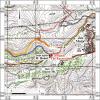Vertical tabs
A salvage excavation revealed a large part of the church's nave. At the time of the survey in 1990's some of the walls were preserved to a height of two m. The preservation of the site, at the time of excavation was poor. Since the excavation, the mosaic pavement has been almost completely destroyed.
The hall, uncovered in the early excavation (1985-6), was adorned with two mosaic carpets, one of which bore a Greek inscription. Although an apse is mentioned in the inscription (dated to 594 or 609 CE- see Epigraphy), no traces of it have been found. A later excavation (2015-2016) revealed a hall beyond the eastern wall of the hall mentioned above. This hall had a north-south orientation and remains of springs of two arches were uncovered. In the center of this hall was a shaft leading to a burial chamber. The entrance had been covered by stone slabs, one of which remains in situ.
A doorway in the southern wall led into another hall, decorated with a mosaic floor of which only traces remain, which may have served as a diakonikon although the excavators suggested that a room to the north served as such.
About seven meters east of the church a second structure was unearthed. A large number of tiles (0.20 x 0.20 m) were found in the excavation. Based on these,the excavator suggested that the structure may have been a bathhouse.
A rock-cut shaft leads down through 8 hewn steps into the burial chamber (2.4 x 2.6 m; 1.4 m high), with a bedrock floor. The entrance was covered by stone slabs, one of which remains in situ. Marks in the floor indicate that there had been a coffin.
A detached structure located west of the main structure may have served as a pilgrims' hospice.
A bell shaped cistern was located in a room south of the prayer hall (not excavated).
A winepress was located about 12 m from the church. Two phases of the Byzantine period were discerned. In the first phase it included: a square treading floor paved with red and white tesserae, a large square settling tank and a square collecting vat connected to it via a hole.
In the second phase the winepress was expanded into a complex winepress. The installation consisted of a crushing floor paved in a white mosaic and a plastered collection vat (2 x 1.4 x 2 m with a capacity of 5.60 m3). In the center of the crushing floor, an installation for pressing was uncovered and a channel ran under the mosaic paving to the collecting vat. The collecting vat had a small settling basin in its southwestern corner and its walls were plastered. Two steps led into the vat and in its western wall, a shelf was installed, possibly to rest vessels. Five smaller units built around the treading floor may have served as smaller presses, each contained a treading floor and a collecting vat.
| Category | Description |
|---|---|
Inscription - see under epigraphy | |
Pottery | A thin-walled jug; an imported amphora.
Found in the wine press: bowls; krater; cooking pots; Gaza ware jar. |
Oil lamps | A complete oil lamp dated to the late Byzantine period.
Fragments of lamps from the Mameluk period. |
| Church type | Diakonikon | Link to church section | Church location |
|---|---|---|---|
unknown | Diakonikon | Ḥorvat Hanot - Church | Ground floor |
Suggested
Epigraphic
The mosaic pavement showed signs of iconoclasm and mending. It was abandoned before the great earthquake of 749 CE as hardly any finds of the Early Islamic period were recovered.





